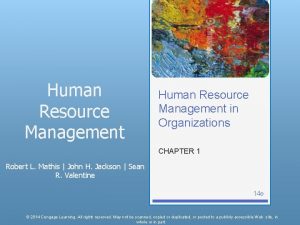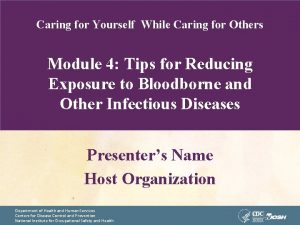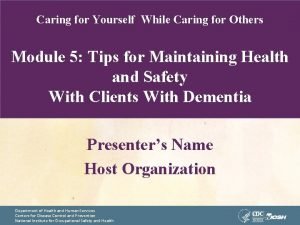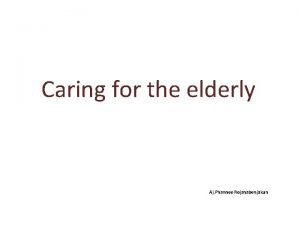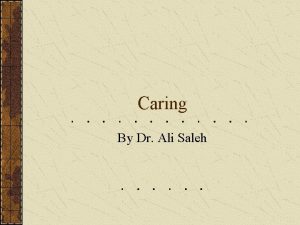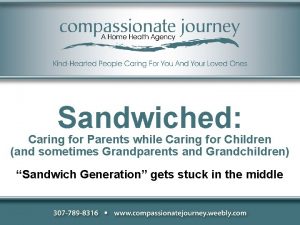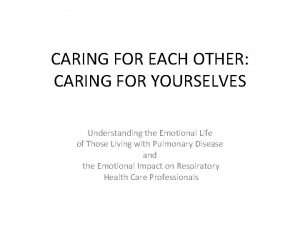1 Current Issues in the US Caring for

















































- Slides: 49

1 Current Issues in the US: Caring for the Patient beyond HIV Infection Ann M. Khalsa, MD, MSEd, AAHIVS Mc. Dowell (HIV/AIDS) Healthcare Center, MIHS Arizona AIDS Education and Training Center Phoenix, Arizona, USA 1

2 Case Outline § Anneliese H. § Diabetes § Hyperlipidemia § Antiretroviral selection § Teri A. § Coronary heart disease § Hepatitis C § Antiretroviral selection 2

3 Anneliese – Case Overview § 42 year old heterosexual Caucasian female, Dx HIV+ 2002 § SH: Divorced female, lost custody of 3 children Recurrent adult cocaine use (rehab programs twice) History of childhood abuse 2007 lost job and insurance § FH: Diabetes, hypertension, bipolar disease, CAD (father MI at 60 yr) § PMH: Diabetes Hyperlipidemia Cervical dysplasia Depression with mood swings 3

4 Anneliese – Case Overview § 3/2009: new to clinic – following 2 year off prescriptions § Sx: polyuria, polydipsia, 15 lb wt loss, GERD, depression with mood swings, genital herpes § PE: BMI 27, Waist 91 cm, BP 110/70 CD 4 # / % HIV-1 RNA ARV Comments Other Results 2002 -2007 500 s UD on ARV TDF-FTC-ATVr 1. 5 year total ARV, Hx rash with EFV 3/2009 82 / 6% 122, 000 Off meds GT negative Creat 0. 81, Ur Prot neg TC 141 / TGA 758 / HDL 26 Gluc 253 / Hgb. A 1 c 9. 6 4

5 Anneliese – ? # 1 § Which of the following therapies need to be started urgently? 1) Antiretroviral therapy 2) OI prophylaxis 3) Diabetes therapy 4) Lipid lowering therapy 5) Anti-depressants Check all that apply 5

6 Anneliese – ? # 1 Answer § Most urgent treatments? 1) Initiation of antiretroviral therapy Underlies ultimate treatment 2) Initiation of OI prophylaxis 3) Initiation of diabetes therapy success Potential immediate complications 4) Initiation of lipid lowering therapy Confounded by high glucose, 5) Initiation of anti-depressants potential pancreatitis risk May underlie ultimate treatment success 6

7 Anneliese – Case Follow-Up § She was started initially on the following: § SMX-TMP 800/160 mg – once daily § Metformin 500 mg – twice daily § Gemfibrozil 600 mg – twice daily § Acyclovir 400 mg – twice daily (all available through discount pharmacy program) § Antiretrovirals not initially available due to lack of funding 7

8 Anneliese –? # 2 § At her follow-up appointment 2 months later she was tolerating the metformin and gemfibrozil, but her random glucose in clinic was 301. Which of the following would be your next step in treating her diabetes? 1) Intensive dietary modification 2) Increased metformin dose 3) Metformin combined with a sulfonylurea or a thiazolinedione 4) Short and long acting Insulin --- Choose all that apply --- 8

9 Anneliese –? # 2 Answer § Which one of the following would be your next step in treating her diabetes? 1) Intensive dietary modification Counseling done 2) Increased metformin dose Increased to 850 mg 3) Metformin combined with a sulfonylurea or a thiazolinedione Glyburide added 4) Short and long acting Insulin 9

10 Anneliese – ? # 2 Discussion § Diabetes treatment sequence: Hgb A 1 c Strategy Medications 6 -7 Monotherapy Metformin, TZD, or sulfonylurea, or newer drug 7 -8 Combination therapy 2 of the above 8 -10 Intensified combination therapy Increased doses Multi-class >10 Insulin Long and short-acting Am. Assoc. Clin. Endocrin. , Endocrine Practice 2007, 13: 3 -68; Am. Diab. Assoc. , Diabetes Care 2010, 34: S 11 -S 61. 10

11 Anneliese – ? # 2 Discussion § Standard diabetes medications: Medication Advantages Disadvantages / Risks Metformin Insulin resistance No weight gain NASH, TGA, LDL Thiazolidinedione Weight gain Insulin resistance Edema (not in CHF) TGA, HDL Caution in hepatic Endothelial function impairment Sulfonylurea Insulin secretion Effective after -cell failure Risk lactic acidosis Caution with renal or hepatic impairment or unstable CHF Weight gain Hypoglycemia Weight gain 11

12 Anneliese – ? # 2 Discussion § Dietary recommendations: Food Group Diabetes Hyperlipidemia Fats: - Total < 30% - Saturated < 10% - Cholesterol < 300 mg/d 25 -35% < 7% (if high LDL) < 200 md/d Soluble Fiber 25 -50 g/d 10 -25 g/d Carbohydrates “Low carbohydrate” 50 -60% whole grains, fruits/vegies whole grains, fruits/vegies Other Insulin resistance: - 500 -1000 calories - 5 -7% weight loss plant sterols and stanols (% of total daily calories) 12

13 Anneliese – ? # 3 § In July 2009 the patient was able to start ARVs. She reports an irregular eating schedule and problems with adherence. Which of the following 3 rd ARV agents would be appropriate along with a 2 -NRTI backbone? 1) Atazanavir-ritonavir 2) Darunavir-ritonavir 3) Efavirenz 4) Fosamprenavir-ritonavir 5) Lopinavir-ritonavir 13

14 Anneliese – ? # 3 § 3 rd ARV agents options: 1) Atazanavir-ritonavir Ø Antacid caution 2) Darunavir-ritonavir Ø Dosing with food 3) Efavirenz Ø History of rash and mood disorder 4) Fosamprenavir-ritonavir Ø Dosing without food 5) Lopinavir-ritonavir Ø Higher rate TGA 14

15 Anneliese – Case Follow-Up 3/2009 CD 4 # 7/2009 8/2009 1/2010 82 / 6% -- 71/10% 116/12% HIV-1 RNA 122, 000 212 <75 ARV Off meds -ABC-3 TCFPVr - Same -- 254 / 879 / 31 318 / 8. 1 269 / 7. 7 TC/TGA/HDL 141/ 758 /26 FBS/Hgb. A 1 c 253 / 9. 6 - Metformin 500 bid 5/2009 None -- - Metformin - Same 850 bid Medications - Glyburide - Same Start Dates 10 mg daily - Gemfibrozil - Same 600 bid - Same 15

16 Anneliese – ? # 4 § The patient has achieved viral suppression with beginning immune recovery. What additional steps can be taken to control her glucose and lipids? 1) Evaluate for secondary causes of dyslipidemia 2) Add additional lipid reducing medications 3) Add additional glucose reducing medications 4) Reinforce lifestyle changes of diet and exercise 5) Change antiretroviral regimen --- check all that apply --16

17 Anneliese – ? # 4 Answer § The patient has achieved viral suppression with beginning immune recovery. What additional steps can be taken to control her glucose and lipids? 1) Evaluate for secondary causes of dyslipidemia 2) Add additional lipid reducing medications 3) Add additional glucose reducing medications 4) Reinforce lifestyle changes of diet and exercise 5) Change antiretroviral regimen --- also an option 17

18 Anneliese – ? #4 Discussion § Secondary causes of hypertriglyceridemia: § Diseases: hyperglycemia , chronic kidney disease, HIV § Lifestyle: alcohol, smoking, inactivity, high carbohydrate diet, overweight § Drugs: estrogens, thiazides, -blockers, steroids, protease inhibitors § Additional treatments for hypertriglyceridemia: § Niacin: problematic side effect of hyperglycemia § Omega 3: additional cardio-protective benefit § Statins: anti-inflammatory and cardio-protective benefit 18

19 Anneliese – Case Follow-Up § The patient returns after 10 month absence from clinic due to loss of insurance. She's treated for candida vaginitis. 3/2009 CD 4 # 1/2010 12/2010 82 / 6% 116/12% 24/5% HIV-1 RNA 122, 000 <75 26, 053 ARV Off meds Same Off meds TC/ TGA/ HDL/ LDL 141/ 758 / 26/ -- 254 / 879 / 31/ -- 278/ 1904/ 27/ -- 253 / 9. 6 269 / 7. 7 334 / 11. 8 FBS/Hgb. A 1 c Meds -Met. 5002 -Gem. 6002 7/2009 ABC-3 TC-FPVr -Met. 8502 -Glyb. 101 -Gem. 6002 Same Off meds 19

20 Anneliese – ? # 5 § In addition to providing OI prophylaxis and restarting gemfibrozil, how would you manage her ARVs and DM medications at this time? 1) Resume prior ARVs and oral diabetes regimen 2) Resume prior meds and add insulin 3) Start new ARV regimen while resuming her prior oral diabetes regimen 4) Start new ARV regimen, resume her prior oral diabetes regimen and add insulin 20

21 Anneliese – ? # 5 Answer § In addition to providing OI prophylaxis and restarting gemfibrozil, how would you manage her ARVs and DM medications at this time? 1) Resume prior ARVs and oral diabetes regimen 2) Resume prior meds and add insulin 3) Start new ARV regimen while resuming her prior oral diabetes regimen 4) Start new ARV regimen, resume her prior oral diabetes regimen and add insulin 21

22 Anneliese H – Case Follow-Up 3/2009 CD 4 # 1/2010 12/2010 3/2011 82 / 6% 116/12% 24/5% 37/7% HIV-1 RNA 122, 000 <75 26, 053 423 ARV Off meds Same Off meds TC/ TGA/ HDL/ LDL 141/ 758 / 26/ -- FBS/Hgb. A 1 c Meds 7/2009 ABC-3 TCFPVr 253 / 9. 6 -Met. 5002 -Gem. 6002 -Met. 8502 -Glyb. 101 -Gem. 6002 254 / 879 278/ 1904/ / 31/ -27 / -- ABC-3 TCFPVr 265/ 486/ 31/ 132 269 / 7. 7 302 / 10. 6 Same 334 / 11. 8 Off meds -Met. 8502 -Glyb. 101 -Gem. 6002 22

23 Anneliese – ? # 6 § Her HIV and lipid status show good initial improvement but her diabetes remains poorly controlled. What additional step/s would you take to control her diabetes? 1) Increase dose of metformin 2) Add thiazolidinedione 3) Add “post-prandial” newer agent 4) Change to combined short and long-acting insulin regimen 5) Add thiazolidinedione and long-acting insulin 23

24 Anneliese – ? # 6 Answer § Additional step/s to control her diabetes? 1) Increase dose of metformin Insufficient 2) Add thiazolidinedione Option 3) Add “post-prandial” newer agent Need home glucose testing 4) Change to combined short Difficult adherence and long-acting insulin regimen 5) Long-acting insulin Insulin recommended @ Hgb. A 1 c >10 24

25 Anneliese – ? #6 Discussion § Current insulin recommendations (Hgb. A 1 c >10): § Long-acting basal (Lantus, Levemir or NPH) ---plus--§ Rapid acting synthetics (Aspart, Lispro, Glulisoline) INSULINS Aspart (Novo. Log) Lispro (Humalog) Glulisine (Apidra) Onset 5 -15 m Peak 30 -90 m Dur’n <5 h Regular NPH Glargine (Lantus) Detemir (Levemir) 30 -60 m 2 -4 h 3 -8 h 2 -3 h 4 -10 h No peak 5 -8 h 10 -16 h 20 -24 h 6 -23 h 25

26 Anneliese – ? #6 Discussion § Newer diabetes medications: § Post-prandial glucose ( microvascular complications): § Glinides + erratic eating schedules - Renal or hepatic impairment, $$ § -Glucosidase - GI side effects; glucose tablets for rescue inhibitors - Renal or hepatic impairment § Sitagliptan+ weight loss - diarrhea, $$ § Gastric empyting ( satiety): § Exentatide+ no weight gain, minimal hypoglycemia § Pramlinitide + weight loss, - injectable with insulin, $$ 26

27 Anneliese H – Case Follow-Up 3/2009 CD 4 # 1/2010 12/2010 3/2011 6/2011 82 / 6% 116/12% 24/5% 37/7% 58/8% HIV-1 RNA 122, 000 <75 26, 053 <40 ARV Off meds Same Off meds 423 ABC-3 TCFPVr TC/ TGA/ HDL/ LDL 141/ 758 / 26/ -- FBS/Hgb. A 1 c Meds 7/2009 ABC-3 TCFPVr 253 / 9. 6 -Met. 5002 254 / 278/1904 265/ 486/ 879 / /27 31/ 132 31/ -269 / 7. 7 334 / 11. 8 302 / 10. 6 -Met. 8502 Same -Gem. 6002 -Glyb. 101 Same -Gem. 6002 Same -Met. 8502 -Glyb. 101 Off meds -Gem. 6002 -Lantus HS Same 312/ 502/ 35/ 166 87 / 7. 1 Same 27

28 Case Outline § Anneliese H. § Diabetes § Hyperlipidemia § Antiretroviral selection § Teri A. § Coronary heart disease § Hepatitis C § Antiretroviral selection

29 Teri A – Case Overview § 53 year old Caucasian heterosexual female § Hospitalized for MI and Diagnosed HIV+ and HCV+ 8/2010 § Tested due to thrombocytopenia and transaminitis in context of risk history § HIV- in 2000, never tested for HCV § HCV source: ex-partner (2002 -2009) § HIV source unknown § Risk factors: past hx of drugs and prostitution

30 Teri A – Case Overview § No medical care prior to moving to AZ in 4/2010 § PMH: Post-menopausal since 2002 § SH: § FH: Shingles in 1/2010 STDs and PID, G 6 P 1 (CSxn) SAb 2 TAb 3 Cocaine and methamphetamine 1984 -2002 Prostitution 1995 -2003 Smoking: 30 pack-years Childhood sexual abuse by father Mother with colon cancer Paternal grandfather died of MI in 60 s Father alcoholic

31 Teri A – CAD Overview § 8/2010 hospitalized for acute MI: § Left sided chest heaviness, at rest while smoking first cigarette of the morning, accompanied by diaphoresis and SOB § EKG: bradycardia (HR=50) with T-wave inversions and ST depression in anterolateral chest leads § Successive Troponin-I elevation: Time (hr): 1 hr 5 hrs 8 hrs 18 hs 21 hrs (NL <0. 06) 0. 05 1. 81 4. 68 5. 06

32 Teri A – CAD Overview § Only prior symptom was SOBOE with bicycle riding § Sx resolved in ED with nitropaste, aspirin, integrilin (platelet inhibitor), lovenox, and metoprolol § Cath lab: § LAD 40% occlusive lesion midvessel § RCA 50% occlusive proximal lesion, plus near complete occlusion distal vessel § Tx: Extraction thrombectomy with percutaneous transluminal coronary angioplasty distal RCA

33 Teri A – CAD Overview § Echocardiogram: § No regional wall abnormalities § Severe left atrial enlargement with moderately-severe diastolic dysfunction § Mild pulmonary hypertension § Preserved LV systolic function § Normal valves with mild mitral regurgitation § Patient was discharged from the hospital

34 Teri – CAD ? #1 § In the HIV clinic, management of her coronary artery disease should include treatment with all the following EXCEPT? 1) Alpha-blockers 2) Beta-blockers 3) ACE inhibitors 4) Aspirin 5) Statins 6) Omega 3

35 Teri – CAD ? #1 Answer § Management of her coronary artery disease should include treatment with all the following EXCEPT? 1) Alpha-blockers: no CAD benefit 2) Beta-blockers: improved CVD outcome post MI 3) ACE inhibitors: Nitric Oxide, improved CVD outcome post MI 4) Aspirin: inhibits platelet aggregation 5) Statins: Nitric Oxide, LDL 6) Omega 3: endothelial function, HDL

36 Teri – CAD ? #1 Discussion § General CAD management: § Beta-blockers § ACE inhibitors goal HR 50 -60 expect 20 -30% creatinine via intraglomerular pressure § Aspirin 81 -325 mg daily § Statins 1 goal LDL <70 -100 § Omega 3 2 goal HDL >40 § Exercise Nitric Oxide § Smoking cessation vasospasm, atherogenesis, etc § Depression 15 -20% post MI incidence independent predictor mortallity

37 Teri – CAD Case Discussion § CAD follow-up: § Treated with: § § Metoprolol 25 mg twice daily Aspirin 81 mg daily Lisinopril 2. 5 mg daily Omega 3 capsules 1000 mg twice daily § Repeatedly encouraged to stop smoking § Encouraged to exercise § Limited by SOBOE and fatigue (HCV and anemia) § Atorvastatin was deferred during HCV treatment

38 Teri – ARV ? #2 § In the context of CAD and HCV infection which of one of the following antiretroviral medications does NOT have possible reasons to AVOID its usage? 1) Abacavir 2) Efavirenz 3) Lopinavir 4) Raltegravir 5) Ritonavir 6) Tenofovir

39 Teri – ARV ? #2 Answer § In the context of CAD and HCV infection which of one of the following antiretroviral medications does NOT have possible reasons to AVOID its usage? 1) Abacavir 2) Efavirenz 3) Lopinavir 4) Raltegravir 5) Ritonavir 6) Tenofovir cohort “signal” of MI association risk of hyperlipidemia risk of nephrotoxicity (HCV & renal atrophy)

40 Teri – Antiretroviral Treatment § Baseline: GT neg, HLA B*5701 neg § ARV: 3 TC-ETV-RAL started 10/2010 WBC 9/23/2010 11/4/2010 3/10/2011 3500 4300 5200 Lymphocyte 1200 1900 2400 CD 4 Cell abs 257 345 426 CD 4 % Helper T Cell 21 22 23 CD 4/CD 8 Ratio 0. 3 0. 4 11813 (H) <75 NOT DET HIV-1 RNA Quant

41 Teri – HCV ? #3 § In the context of her CAD infection how would you manage her hepatitis C infection? 1) Avoid peg-interferon and ribavirin for one year following the MI due to risk of anemia 2) Evaluate and treat the HCV whenever the patient is stable and ready 3) Avoid peg-interferon and ribavirin entirely due to medication toxicity 4) Consider HCV treatment only if starts to develop significant liver fibrosis

42 Teri – HCV ? #3 Answer § In the context of her CAD infection how would you manage her hepatitis C infection? 1) Avoid for one year due to anemia: diligently manage, but not contraindication 2) Evaluate and treat the HCV whenever the patient is stable and ready 3) Avoid entirely: no cardio-toxicity 4) Only if significant liver fibrosis: not required to wait

43 Teri – HCV ? #4 § Which of the following factors are NOT prognostic of her response to HCV treatment? 1) Fasting glucose 2) HCV genotype 3) HCV quantitative RNA 4) Routine liver ultrasound 5) Liver biopsy

44 Teri – HCV ? #4 Answer § Which of the following parameters will NOT affect her response to HCV treatment? Associated with Poorer Response: 1) Fasting glucose § Insulin resistance 2) HCV genotype §GT 1 3) HCV quant. RNA §High 4) Routine Liver ultrasound §Not applicable 5) Liver biopsy §Bridging fibrosis

45 Teri A – HCV Staging Results § Abdominal ultrasound 12/2010: § Hepatosplenomegaly with 1. 5 cm liver lesion § Left renal atrophy (7. 7 cm length vs 12. 4 cm / right) § No ascites § Abdominal CT 1/2011: § Hepatic nodularity, isolated hemangioma § Left renal cortical scarring § Liver needle core biopsy 3/2011: § Moderate portal, periportal and lobular inflammation § Stage 2 -3 portal fibrosis with occasional bridging fibrosis

46 Teri – HCV ? #4 Discussion Prognostic factors Positive Predictors of Success § § § § § Age BMI Genotype HCV RNA Fibrosis Glucose CD 4 HIV RNA Drugs/Et. OH Psych 53 years 23 3 a 2, 186, 720 Partial bridging 93 After ARV = 426 After ARV = <40 No No No Yes No No/Yes Yes Yes

47 Teri – ARV Treatment Follow-Up § HIV treatment: 3 TC-ETV-RAL since 10/2010 § HCV treatment: RBV-Peg. IFN 2 a since 5/2/2011 CD 4 T Cell Abs 9/23/2010 11/4/2010 3/10/2011 6/6/2011 8/31/2011 257 345 426 348 250 CD 4 % Helper T Cell 21 22 23 31 46 CD 4/CD 8 Ratio 0. 3 0. 4 0. 6 1. 1 11813 (H) <75 NOT DET -- 2, 186, 720 -- 18, 992 <5 HIV-1 RNA Quant Hep C RNA Quantitative, b. DNA

48 Screening for Non-Infectious Co-Morbidities Adapted from EACS Guidelines October 2011 http: //www. europeanaidsclinicalsociety. org/ Disease Assessment CVD • Risk assessment Follow-Up Frequency Comments Framingham score • EKG Conditional HTN • Blood pressure Annual Lipids • TC, HDL, LDL, TG Annual Diabetes • Fasting plasma glucose 6 -12 m • Hgb. A 1 c or oral GTT Conditional if fasting glucose > 100 -125 mg/dl (5. 7 -6. 9 mmol/L) • Risk assessment Annual CKD, DM, HTN, CVD, HCV, medications, family history • e. GFR 3 -12 m More often if: CKD or risk factors present; or if on nephrotoxic drugs (ARV: TDF, IDV, ATV; OI: ganciclovir, amphoterocin; etc. ) • Urine dipstick: protein, blood 6 -12 m Every 6 mo if e. GFR <60 ml/min • Spot urine Prot: Creat Conditional If proteinuria 1+ or e. GFR <60 ml/min • Calcium, PO 4, Alk. Phos 6 -12 m • Risk assessment 2 y FRAX score in patients >40 yr • DXA scan Conditional In at-risk patients • 25 OH Vit D Conditional In at-risk patients: malabsorption, PO 4 wasting, dark skin, CKD, dietary deficiency, lack of sunlight exposure Renal Bone Consider prior to PI with potential conduction problems Repeat fasting prior to medical intervention

49 Screening for Non-Infectious Co-Morbidities - Continued Disease Assessment Follow-Up Frequency Comments Liver • Risk assessment Annual More frequent on hepatotoxic drugs • ALT/AST, Alk. Phos, Bilirubin 3 -12 m Neuro. Cog • Screening questions 2 yrs Rule out confounding conditions Depression • Screening questions 1 -2 yrs More frequent in at-risk patients Cancer • Mammography 1 -3 yrs W: 50 -70 yrs or W/M: high risk history • Cervical Pap • Colposcopy 1 -3 yrs W: Sexually active For ASCUS Pap • DRE and Anal Pap 1 -3 yrs MSM: evidence preliminary M/W: high risk (HPV dis or RAI) For ASCUS Pap • Ultrasound and AFP 6 mo Patients with cirrhosis – from any cause • DRE PSA 1 -3 yrs M >50, or high risk • FOBT or • Colonoscopy 1 -3 yrs 5 -10 yrs 50 -75 yrs, or high risk • Anoscopy
 Dr. jean watson
Dr. jean watson Current issues in counseling profession
Current issues in counseling profession Ba 635
Ba 635 Current issues in ict
Current issues in ict Current marketing issues
Current marketing issues Current issues in classroom testing
Current issues in classroom testing Current issues in human resource management
Current issues in human resource management Vimeforum
Vimeforum Current and future issues in corrections
Current and future issues in corrections Keizen event
Keizen event Language assessment principles and classroom practices
Language assessment principles and classroom practices Hazard based safety engineering
Hazard based safety engineering Drift current and diffusion current in semiconductor
Drift current and diffusion current in semiconductor Lesson 4 three-phase motors
Lesson 4 three-phase motors Slideplayer
Slideplayer Line current and phase current
Line current and phase current Non planar circuit
Non planar circuit Ceramic composition resistors
Ceramic composition resistors Drift current density unit
Drift current density unit Phase to phase voltage
Phase to phase voltage Drain current in the constant-current region increases when
Drain current in the constant-current region increases when Why is sma welding current referred to as constant current?
Why is sma welding current referred to as constant current? Drift current and diffusion current
Drift current and diffusion current Wye and delta connections
Wye and delta connections En lathund för arbete med kontinuitetshantering
En lathund för arbete med kontinuitetshantering Anatomi organ reproduksi
Anatomi organ reproduksi Egg för emanuel
Egg för emanuel Formel gruplar
Formel gruplar Rutin för avvikelsehantering
Rutin för avvikelsehantering Treserva lathund
Treserva lathund Myndigheten för delaktighet
Myndigheten för delaktighet Presentera för publik crossboss
Presentera för publik crossboss Mall debattartikel
Mall debattartikel Kung som dog 1611
Kung som dog 1611 Tack för att ni lyssnade
Tack för att ni lyssnade Tobinskatten för och nackdelar
Tobinskatten för och nackdelar Tack för att ni lyssnade bild
Tack för att ni lyssnade bild Atmosfr
Atmosfr Referat mall
Referat mall Ruin karttecken
Ruin karttecken Mitos steg
Mitos steg Verifikationsplan
Verifikationsplan Rbk-mätning
Rbk-mätning Arkimedes princip formel
Arkimedes princip formel Förklara densitet för barn
Förklara densitet för barn Elektronik för barn
Elektronik för barn Tack för att ni har lyssnat
Tack för att ni har lyssnat Smärtskolan kunskap för livet
Smärtskolan kunskap för livet Argument för teckenspråk som minoritetsspråk
Argument för teckenspråk som minoritetsspråk Mjälthilus
Mjälthilus






